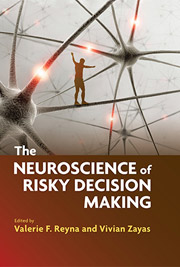Book debuts brain models of risky decision-making
By Karene Booker

Risky choices – about sex, drugs and drinking, as well as diet, exercise, money and health care – pervade our lives and can have dire consequences. Now, a new book aims to help us understand the neural roots of bad decisions. “The Neuroscience of Risky Decision Making” (APA Books) synthesizes the research in this relatively young field for the first time, and introduces new models of brain function to explain and predict risky behavior.
“The harm caused by risky decision-making is enormous – understanding how the brain processes risks and rewards is the key to unraveling the mystery of irrational decision-making in real life,” said Valerie Reyna, professor of human development, director of the Human Neuroscience Institute in the College of Human Ecology and co-director of the Cornell MRI Facility.
“We anticipate this work will transform the next phase of research in the field and inform policy and practice innovations that can save lives and improve health and well-being,” said Reyna, who co-edited the volume with Vivian Zayas, associate professor of psychology at Cornell.
In the book, leading neuroeconomists, neuroscientists and social scientists discuss recent findings on why people take risks and how risky choices shift in different circumstances and across the life span.
An initial chapter by Reyna and Scott A. Huettel, neuroscientist at Duke University, sums up the research on how the brain responds during risky decision-making and introduces a new theoretical framework for explaining the mechanisms that drive behavior. The chapters that follow cover such topics as how risky decision-making changes dramatically from childhood to adolescence as a function of age-related changes in brain structure; the role of emotional regulation, self-control and personality differences in risky choices; and the social, cognitive and biological factors that shape risky behavior. The final chapter presents evidence for a new “triple” process model of how rewards and losses are evaluated in the brain, potentially resolving conflicts between current single and dual system theories.
The book is intended for researchers, students and professionals in the fields of social, cognitive and affective neuroscience; psychology; economics; law and public health.
This volume is part of the American Psychological Association’s Bronfenbrenner Series on the Ecology of Human Development, with authoritative contributions from leading experts in the field.
Reyna will discuss her new book in a “Chats in the Stacks” book talk Feb. 10 at noon in 160 Mann Library.
Karene Booker is extension support specialist in the Department of Human Development.
Media Contact
Get Cornell news delivered right to your inbox.
Subscribe